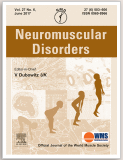 Myositis constitute a group of acquired neuromuscular diseases in connection with a dysregulation, of varying intensity, of the immune system. The production of autoantibodies usually signs the diagnosis. Among the inflammatory myopathies, one distinguishes in particular the polymyositis, the dermatomyositis and the myositis with sporadic inclusions, and an entity more recently described: the immune-mediated necrotizing myopathy (IMNM). Unlike the former, IMNM shows little or no inflammatory character on the histology. The definitive diagnosis is now based on the positivity of autoantibodies directed against an enzyme, HMG-coreductase (HMGCR) and / or against the protein SRP.
Myositis constitute a group of acquired neuromuscular diseases in connection with a dysregulation, of varying intensity, of the immune system. The production of autoantibodies usually signs the diagnosis. Among the inflammatory myopathies, one distinguishes in particular the polymyositis, the dermatomyositis and the myositis with sporadic inclusions, and an entity more recently described: the immune-mediated necrotizing myopathy (IMNM). Unlike the former, IMNM shows little or no inflammatory character on the histology. The definitive diagnosis is now based on the positivity of autoantibodies directed against an enzyme, HMG-coreductase (HMGCR) and / or against the protein SRP.
In an article published in June 2020, Chilean clinicians report the case of a girl aged 8.5 diagnosed with IMNM on the basis of histological and especially immunological evidence. Clinically, since the age of 3.5, she had presented a picture compatible with an isolated and very little progressive form of girdle muscular dystrophy (LGMD): progressive deficit in the pelvic and shoulder girdles, significant rise of CPKs in serum level. Genetic investigations (panel of 23 LGMD genes) were negative. This child had only received immunoglobulin therapy at the onset of her illness. With four years of follow-up, she regained her muscle strength, despite still very high CPKs and fatty infiltration on muscle MRI which remained stable. The authors note that this apparent spontaneous remission of his IMNM is not usual, even in pediatric forms.
